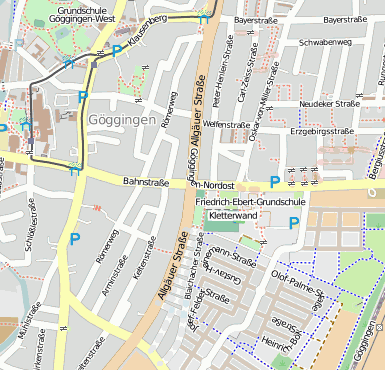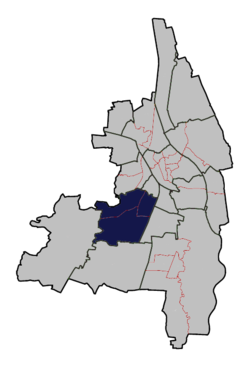Augsburg-Göggingen
- 37 Goeggingen Northwest
- 38 Goeggingen -northeast
- 39 Goeggingen East
- 40 Goeggingen -South
Goeggingen is a district in the south of Augsburg. It comprises the four districts 37 Goeggingen - Northwest, 38 Goeggingen -northeast, 39 Goeggingen - East and South - Goeggingen 40. Together they form the XIV planning area of Augsburg, an area of 10.79 km ² and 17,722 inhabitants (as of 1 January 2006). In the south of Goeggingen the wastelands wheel and wheel mill direction Leitershofen are the sheep pasture settlement.
Geography
The old community Goeggingen, located on Wertach and Singold, stretches south from Pfersee and the Antonsviertel. Here it was largely grown together in the 19th century with the city. In the east Goeggingen is bounded by high-field, and the University District, in the south it borders on Inningen, southwest of Bergheim and in the west by the district Leitershofen the city Bergen.
History
As early as the Bronze Age and Hallstatt period, the area was inhabited over the Wertach shore at the edge of the high terrace, and also found settlements and grave finds from the Roman period from the 1st to the 4th century. Perhaps here was the water line to supply the capital Augusta Vindelicorum, is proven safe on the territory of the municipality, the route of a Roman road. The Allgäu road from Augsburg to Kempten and on to Bregenz and the Alps to Lake Como went to almost 4 km across the district, according to the present Roman road and the road Gögginger; a milestone has, however, just south found only on Inninger territory of the municipality border. After the end of the Roman period settlement, the area was settled by the Alemanni. The place " Geginga " is first mentioned in 969 in a document of St. Ulrich of Augsburg.
From 1804 to 1862 was in Goeggingen the seat of the District Court and District Office. Due to the orthopedic medical institutions of Friedrich Hessing the Augsburg suburb as a resort was nationally known, the twisting and Nähfadenfabrik Goeggingen (now Amann Group) was the largest employer until the 1970s. In 1954, Goeggingen the sponsorship of the basis of the Beneš decrees in 1945 disenfranchised, dispossessed and displaced from their ancestral homeland residents of the city and the county Neudek in the Sudetenland. With the influx of the Sudeten Germans and the economic development Goeggingen grew to 16,000 inhabitants. In 1969, the market town Goeggingen became a town, but already incorporated 1 July 1972 as part of the great Bavarian municipal reform, together with the neighboring villages Haunstetten, Inningen and Bergheim to Augsburg.
Attractions
- Kurhaus Goeggingen with the park and the park theater
- Catholic Parish Church of St. George and Michael
- Factory building Ackermann at the factory road (location of the evening series velvet and silk)
- Workers colony
- Roman Tower replica with the Augsburg quadrant
- Hessing Clinic with several buildings (including Hessingburg ) and a support center for children
- Dr. Maidl villa, one of the oldest buildings Göggingens, said to have been in the Wolfgang Amadeus Mozart several times guest.
Business
- Amann Sewing Threads, formerly Ackermann Goeggingen and its predecessor twisting and Nähfadenfabrik Goeggingen ( ZNFG )
- Rgerbr, Bürgerliches Brauhaus Augsburg- Goeggingen
- Faience Goeggingen (1748-1752), manufactory for earthenware and majolica
- Richard Hoerl, watch factory
- Hosokawa Alpine, Mechanical Engineering
- Renk, engineering
Traffic
Pass through Goeggingen as mayor -Müller - ring the federal highways 17 and 300 to the east of Augsburg Messe Bahnhof is located with access to the railway Augsburg- Buchloe. The district is accessible by the public transport with buses and the tram line 1, the route is currently served until November 2013 due to construction work by the rail replacement bus service.
Sports
The TSV Goeggingen was founded in 1875 and reached especially in handball and athletics greater success, but has in addition also departments for football, gymnastics, table tennis, gymnastics and volleyball. Also located in Goeggingen skaters Union Augsburg was a founding members of the Bundesliga in the inline skater hockey in 1996 and remained there until 2001.
Train
- Primary school Goeggingen -West " Park School"
- Friedrich- Ebert Elementary School Goeggingen East
- Friedrich- Ebert- secondary school with middle - ripening train
- High school and junior high school Mariastern
- Schubert School (part of the Ulrich- needs school )
Groups of children / Vorkindergärten
- Nursery St. John e.V.
- Gögginger Children 's Ark
- Unibärchen
- Somersault (TVA )
Kindergartens
- Urban daycare Fabrikstraße
- Urban daycare Josef Felder- Straße
- Catholic Kindergarten St. Anna
- Daycare of the Lutheran. Parish of Trinity Church
- AWO " Rumpelstiltskin "
- Hessing Kindergarten
- Villa Sundries PLUS
Personalities
Sons and daughters of the town
- Thoma (* 1873), lawyer, Reichstag and Landtag
- Josef Schmid (1901-1956), Lieutenant-General of the Air Force in World War II
- Fritz Bäuml (1945-2005), football player
- Uta Schorn ( b. 1947 ), actress
- Axel Wirth ( born 1951 ), lawyer
- Helmut coarse ( b. 1968 ), table tennis players
- Anton Bezler, Turner
- Anton Michael Mayer, (1936-2010), football player
- Roy Black (1943-1991), pop star
Other personalities who are associated with the place
- Eitel Hans Lange Coat (1480 - 1528), a member of the Augsburg Anabaptist congregation, is held some time on the run in front of the captors of the Swabian League in Goeggingen.
- Friedrich Hessing (1838-1918), orthopedic pioneer, founded in Goeggingen an orthopedic hospital
- Michael Short (1876-1957), architect, lived from 1907 in Goeggingen








.jpg)
